Clogs
In ancient times wooden shoes or clogs have been widely used. They were
ideal footwear at a time that roads were not yet covered with stones or
other hard surfaces. They protected against dirt and mud and could
easily be put on and off when going in and out. Dutch and Swedish clogs
are still known all over the world but only a few know about Japanese
clogs.
Dutch clog skates

To the Dutch it seems only a matter of course
that once there have been clogs with skating blades underneath. But
skates as
shown here have never been made industrially. They are quite scarce and
seem to have been made for fun only. The clog skates in this picture
have no marks and look as if they have never been used for skating. They
were made in the second quarter of the 20th century.
Japanese geta-skates
Also in Japan clogs have been common footwear. Unlike Dutch clogs
Japanese clogs do not have the appearance of a shoe or boot. They
consist of a wooden platform with two stilts placed athwart underneath.
The stilts can vary in height from 2-4 inches and must prevent a kimono
from being dragged through street dirt. They were called geta
(pronounce ge as in get and ta as in tart). Japanese geta (in Japanese
no plural exists) have hanao, V-shaped harnesses as with toe
slippers. Traditional hanao are red for women and black for men. As geta
do not have protective caps for the toes protection against cold must
come from tabi, a kind of mitten-socks. In winter time thick
waterproof tabi were worn. The pictures show two kinds of geta skates.
It seems odd that geta skates do not have heel straps or so, but it is
most likely that Japanese are that accustomed to wearing geta that they
have very strong toe muscles.
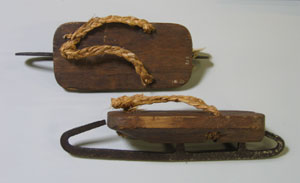 |
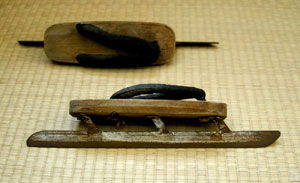 |
Japanese texts seem to
hint that geta skates were used on hard snow rather than on ice. Skating
almost must have been a kind of walking then. The picture below was made
around 1925 and proofs that they have been used indeed.
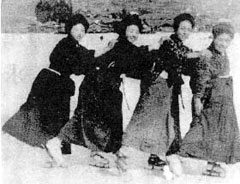
The photo's underneath show a striking resemblance between Japanese geta
and Dutch trips. Trips were a kind of open clogs that are known
to have been used from the 14th till the 17th century. They consisted of
a wooden sole with two short stilts underneath and two triangular pieces
of leather at the top that could be connected by a lip and notches to
fit the individual foot size. The photo's show the remains of 15th
century trips with nails in the stilts as to provide for more grip on
slippery surfaces like ice. It might be possible that this design was
introduced in Japan by the Dutch during their stay in Nagasaki/Decima
(1648-1823).
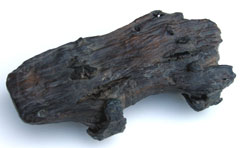 top view of trip |
 bottom view of trip with nails |
Russian question
At excavations in April 2006 near Mozahaisk (Moscow) shoe soles were
found in a 12th/13th century earth layer that have metal heart shaped
platforms underneath. As with the trips these platforms sit in the
middle of the soles. But, the soles were made of leather instead of wood
and hence going on them must have been very uncomfortable. The Institute
of Archaeology of the Academy of Sciences of the Russian Federation,
that did the searching, wonders if the hearts have had a function that
can be related to ice skating as they seem to have stimulated gliding
rather than preventing it. They therefore would like to receive any
comment onlookers may have.
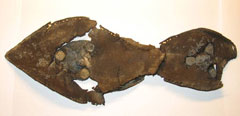 top view Russian sole |
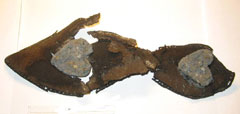 bottom view Russian sole |
© 2002-12 The virtual Ice Skates
Museum. All rights reserved.
home |
sitemap |
copyright |
contact